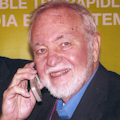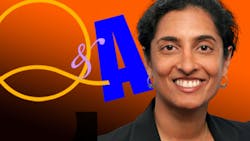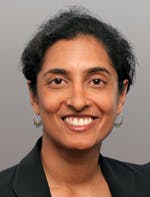Interview: Freescale’s Ritu Favre Discusses Today’s RF Technologies
ED:Tell us something about Freescale’s RF Division. What is the scope of the products?
RF: For over 20 years, Freescale has been the leader in defining “what’s next” in RF. In the 1990s when bipolar was the industry standard, Freescale was the first to introduce laterally diffused metal-oxide semiconductors (LDMOS), and that enabled multi-generational improvement in power amplifier (PA) performance. In the 2000s when discrete ceramics were the industry standard, Freescale was the first to launch radio-frequency integrated circuits (RFICs) and plastic packaging, thereby enabling compact, easy-to-design PAs.
Today, with a significant market share lead in RF power amplifiers, Freescale is successfully leveraging our technology position to grow revenue outside of cellular infrastructure in areas such as millimeter-wave monolithic integrated circuits (MMICs), RF industrial, RF military& aerospace, and land mobile markets.
ED: What products make up the greatest percentage of the business?
RF: Today our largest revenue stream is from RF cellular markets (basestation PAs).
ED: What key factors are driving your RF business right now?
RF: Cellular networks are continuing to transform from voice-centric to data-centric in nature, and the accompanying explosion in mobile data usage has led to expansion and upgrades of cellular networks. In turn, this has created a healthy demand for our products and led to growth in our businesses. Our announcement earlier this year that we are entering the RF military & aerospace markets has also been very well received, and we are getting significant pull there. Our overall industrial offerings also continue to gain traction, and we are performing very nicely in these areas.
ED: Are you developing any products for the automotive/telematics/connected car market?
RF: Freescale is a major supplier of semiconductors to the automotive industry. Our sister business groups within Freescale are developing platforms and solutions for inter-vehicle communications and advanced driver assistance including radar-based communications. Freescale has a broad portfolio of automotive microcontrollers, integrated circuits, and sensor solutions. Specifically in the RF business, there are sections of our group that participate in the connected car market.
An example of this would be the development of high-definition FM (HDFM) and radio data system-traffic message channel (RDS-TMC), where traditional radio stations can now broadcast traffic information through FM transmitters. We lead the pack in FM RF power transistors. Additionally, as part of our emerging market product team, we are working on other RF automotive applications such as plasma ignition.
ED: Freescale is a leader in LDMOS power transistors. Is that business still solid given the big interest in gallium nitride (GaN)?
RF: Freescale’s objective to remain a market leader can only be fulfilled if we are able to provide the right solutions at the right price across the market segments we serve. To enable this, our technology investments span LDMOS, GaN, gallium arsenide (GaAs), and other technologies. Today, the cellular infrastructure market is by and large still an LDMOS-dominant market. So, yes, our LDMOS outlook is quite strong as we look forward. There are niche applications where wide band gap provides differentiation, and we are investing in these areas. For example, at S band there are performance-to-cost ratios that must be considered, and at C and especially X band, the performance benefits of GaN make it attractive.
ED: Are you doing anything with GaN?
RF: We are developing GaN products for markets that can derive the most benefit from the advantages that GaN has to offer, such as higher Ft, broadband, and power density. This year we announced our initial offerings for cellular infrastructure and broadband land mobile applications. In addition to that, we are investing in GaN development at C and X band, where GaN provides significant performance benefits.
ED: What is the status of the Doherty amplifier business?
RF: Doherty remains the workhorse of high-power RF PAs. Although alternative architectures are always being developed, I do not expect Doherty’s status as a critical technology to change in the near future.
ED: What is the future for GaAs RF circuits?
RF: The future for GaAs is very bright, especially in lower-power applications. We expect GaAs to receive a further boost through femtocell markets, both consumer and enterprise varieties. Additionally, using this technology platform we have developed application-specific products such as ADAM, which is a solution that can dramatically reduce production variation in Doherty amplifiers.
ED: Does Freescale have RF circuits for the cellular market?
RF: Yes, Freescale invests heavily in RF power circuits to help reduce our customers’ cycle times and increase performance and time-to-market. We have expanded our single-stage reference circuit design offerings to include full PA lineups, which allow customers to finalize their designs much quicker.
ED: What’s happening with the ZigBee business these days?
RF: Freescale continues to offer ZigBee solutions in smart energy, home automation, and other short-range connectivity applications. The RF business I manage is focused on higher-power solutions, such as the ones mentioned above.
ED: Do you have RF design tools or reference designs that help engineers design?
RF: Absolutely. A very large portion of our investments is in areas that help our customers’ designers reduce the complexity and cycle time of their designs. For example, our FET2 and MET models for RF high-power transistors and RFICs are nonlinear models that simulate electrical phenomena and account for dynamic self-heating. They were specifically developed to model high-power RF transistors and RF ICs. Freescale’s RF models are generally recognized as market leading and enable our customers’ circuit designers to predict prototype performance more accurately.
As mentioned above, we also invest heavily in reference designs. As one example of this, we launched a “130 ways to get smarter” campaign based on our 130 reference designs in the RF industrial space. We will continue to produce more and more of them, as they are a key enabler for us and ease our customers’ design process significantly.
ED: What do you see as the “next big thing” in RF for Freescale?
RF: We understand that true differentiation is needed to maintain and grow cellular market share, and we will continue to focus there. As an example, we believe Freescale’s latest Airfast RF products are best-in-class at multiple frequency bands and power levels. However, for the “next big thing” we are making very significant investments in our industrial and MMIC businesses, and we see a bright future for these application areas.
ED: What challenges have you overcome to get to where you are today?
RF: To reach my current position, I had to overcome many barriers to being credible as a leader. I started in electrical engineering and was one of five women in my bachelor’s classes. By my master’s, I was the only woman. Upon starting at Freescale, I started in manufacturing. I learned leadership skills working in the wafer fab and final manufacturing facilities. In order to progress in my career, I needed to move to a business role. I moved into business management and worked with a number of very intelligent RF engineers. Over time, I began to learn the technology and the challenges. Working closely with the team to gain credibility helped me to achieve the goals I was looking to attain.
ED: What would you say to young girls considering a career in engineering or other STEM fields?
RF: I would say that always go for the hardest and most difficult types of math and science that you can do. Being an engineer is rewarding at so many levels and can lead to so many different types of careers. Math and science can also lead to medical degrees and other advanced degrees that enable entry into technology fields. The jobs are exciting and rewarding.
ED: What new skills do you see influencing the future of RF that new graduates should be cultivating?
RF: Communication skills are vital, such as being able to convey ideas clearly so others can understand them. Understand the person/audience you are talking to and ensure that you think through the best way to get your point across. Be an engineer for many years before making a shift into management. Become an expert in a particular field of engineering before branching out. Work hard, and let your career develop naturally.
Ritu Favreis senior vice president and RF general manager at Freescale. She has 25 years of experience in large corporations, covering all aspects of the value chain including the supply chain, technology, new product introduction, business operations, management, and developing strong customer relationships. She joined Freescale in 1988 and has served as the RF general manager since October 2010. She holds a bachelor’s degree in electrical engineering and a master’s degree in electrical engineering, semiconductor physics, from Arizona State University.
This file type includes high resolution graphics and schematics when applicable.
About the Author

Lou Frenzel
Technical Contributing Editor
Lou Frenzel is a Contributing Technology Editor for Electronic Design Magazine where he writes articles and the blog Communique and other online material on the wireless, networking, and communications sectors. Lou interviews executives and engineers, attends conferences, and researches multiple areas. Lou has been writing in some capacity for ED since 2000.
Lou has 25+ years experience in the electronics industry as an engineer and manager. He has held VP level positions with Heathkit, McGraw Hill, and has 9 years of college teaching experience. Lou holds a bachelor’s degree from the University of Houston and a master’s degree from the University of Maryland. He is author of 28 books on computer and electronic subjects and lives in Bulverde, TX with his wife Joan. His website is www.loufrenzel.com.


